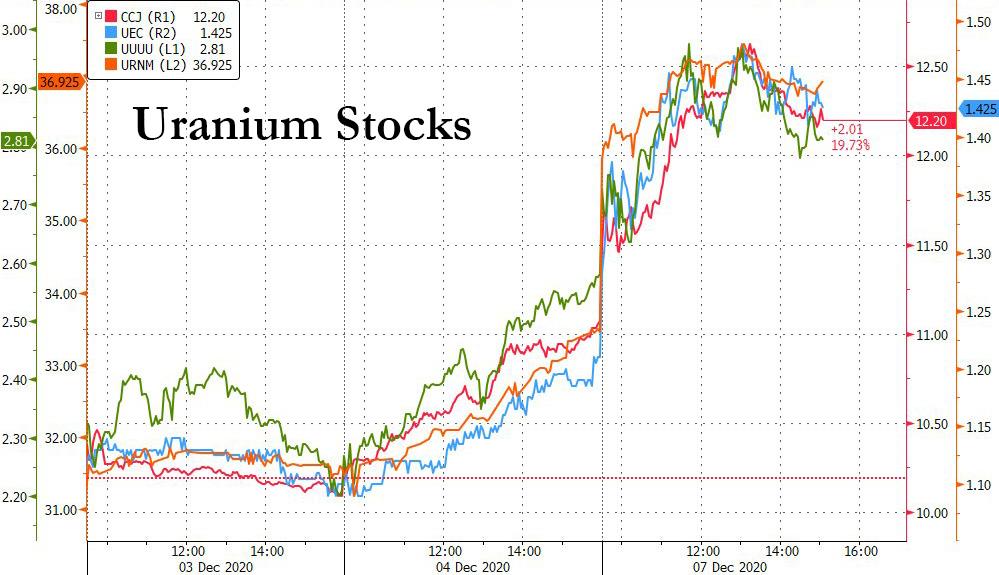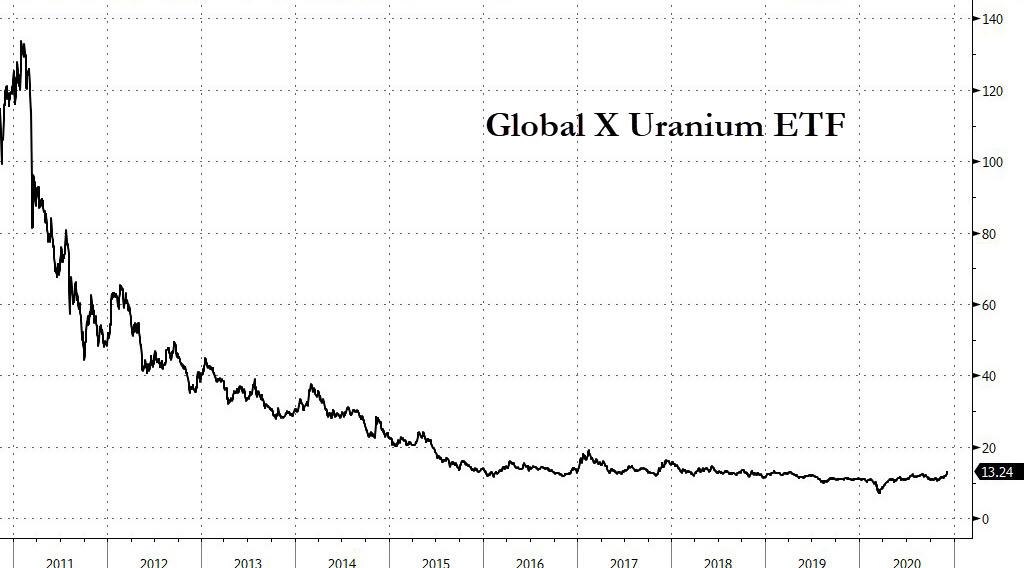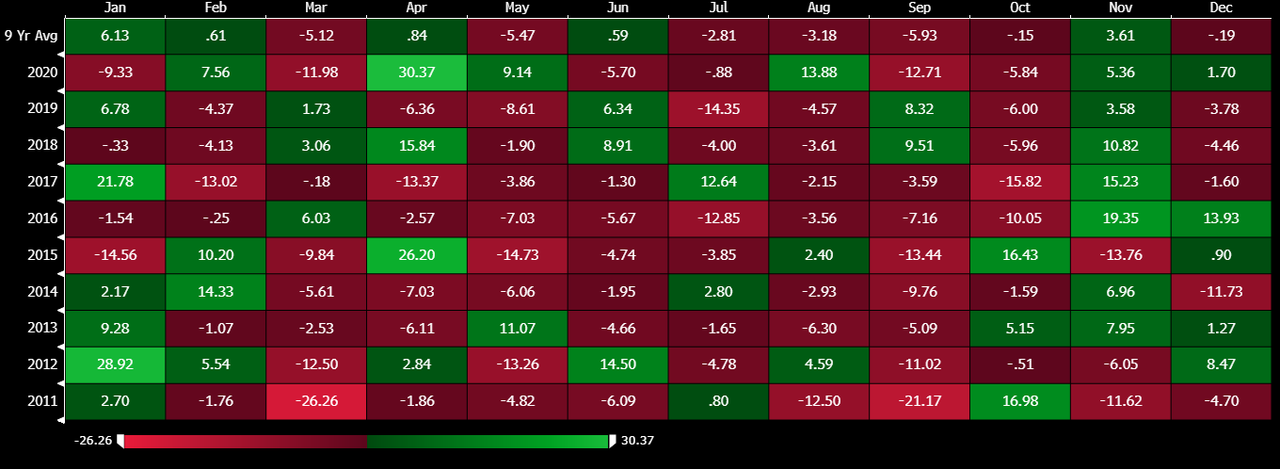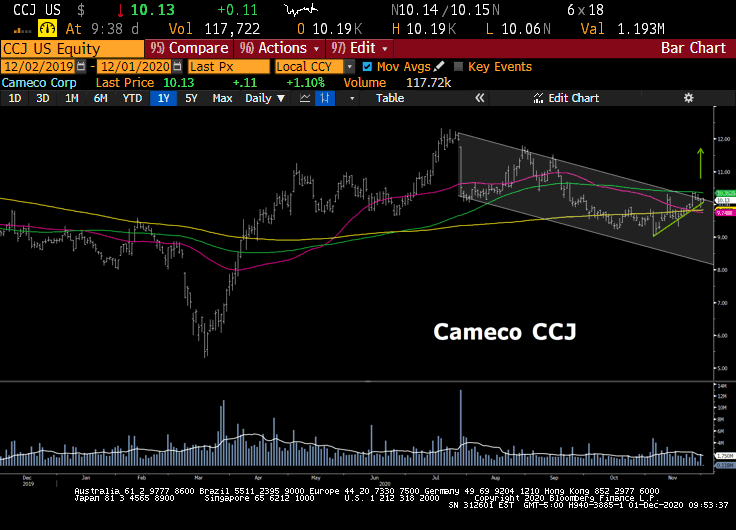Uranium Stock Surge Accelerates After 2nd Covid Case At World’s Highest-Grade Uranium Mine
Tyler Durden
Mon, 12/07/2020 – 15:41
On Friday we discussed the surge in Uranium stocks, asking if “this is the beginning of the next ESG craze.” As a reminder, Friday’s sharp move higher took place after House and Senate lawmakers revealed a compromise version of the annual National Defense Authorization Act. According to S&P Global, the bill effectively provides for the military to continue a policy under President-elect Joe Biden that classifies the domestic supplies of certain minerals such as uranium, graphite and lithium as vital to national security. This sent most uranium companies sharply higher, with names such as Cameco rising 9.7%, Uranium Energy +10%, Energy Fuels +17%, North Short GLobal Uranium Mining +6%.
On Monday, this dramatic move higher has accelerated further, with most names rising double digits if fading modestly in afternoon trading as shown below:
While there was no material catalyst behind today’s move besides traders digesting our note from Friday, Cameco, which controls the world’s largest high-grade uranium reserves and low-cost operations and is one of the largest global providers of the uranium fuel, reported yesterday that an individual at its Cigar Lake uranium mine in Saskatchewan has tested positive for COVID-19. This individual has been in isolation since December 4, according to Kitco.
This was the second confirmed COVID-19 case at Cigar Lake.
Cameco, which soared as much as 15% today, is working with the Northern Population Health Unit and will follow their guidance with contact tracing already started.
Cigar Lake is the world’s highest-grade uranium mine and is located in northern Saskatchewan, Canada. Since commissioning in 2014, the site has produced a total of 82.9 million pounds (100% basis). Commercial operation began in May 2015.
The reaction appears to be a kneejerk response to a similar development this spring: on April 14 Uranium stocks surged after Cameco suspended operations at Cigar Lake due to Covid-19, resulting in supply concerns.
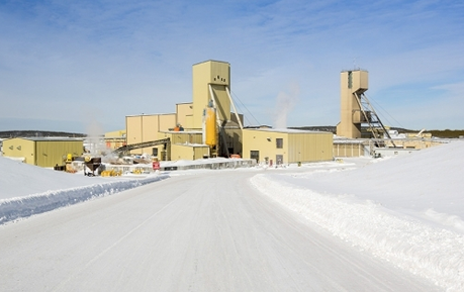
Cameco restarted the Cigar Lake mine in September 2020 after the temporary suspension as a precaution due to the COVID-19 pandemic.
Meanwhile, as we discussed on Friday, and as judging by the recent surge in uranium stocks, it is a growing a possibility that the rabid ESG crowd will start rotating into the Uranium sector which as one look at the Global X Uranium ETF shows, has lots of potential upside. As Bear Traps report author Larry McDonald wrote, “if the mad-mob trading FCEL and other ESG names gets ahold of uranium… Watch out” adding that “we find it more than bizarre that every commodity is ripping and uranium miners are dead in the water. Seasonally and politically, upside CCJ vol looks extremely cheap.”
Below we repost McDonald’s Uranium bull case:
* * *
When are people going to figure out how GREEN Cameco CCJ equity is?!
CCJ Seasonal Returns
Notice how when energy commodities were still rising (2011-2014) CCJ’s December and January returns were very strong. Meanwhile, every commodity stock is the metal space is up 40% in the past month, futures are ripping too yet CCJ and UXA1 are at April levels. CCJ calls are cheap, seasonality looks good, and with all these hot stocks jumping around (FCEL traded 1/2 of its market cap today) I think its only a matter of time before the mad mob finds Uranium equities… Buy the March $11 calls, put them in the drawer.
PM on CCJ Cameco Corp
Agree with your thesis. The space is so small and it makes so much sense. However, it would really be nice to see the spot U price catch a sustainable bid here. I am looking for a turn of the year trade in U, if not sooner. We need to see some utility to ink a relatively good sized contract to get things moving. That would be big. I am also looking for financial players to get more serious about throwing weight around in this sector. A group with decent capital at a multi-strat HF or a medium sized fund could allocate a few hundred mill and create their own reality in this sector, IMO. The order of operations would be to buy up positions in call option like U miners, then buy the U trusts trading at discounts and then hit the spot market hard. I think you would make money on all legs of that if you committed a few hundred mill to it.
Looking at moves in some U stocks recently I wonder if this operation could be starting…
It seemed like the whole U mining sector in Australia was up 13% on Tuesday (several names up that much). We are seeing stuff like UUUU today. And even LEU (+9.6%) which is a name I need to understand better and could have a very interesting role to play in a resurgent US nuclear sector.
I am very excited about the potential here. With NXE and PDN.au my bit positions I am definitely liking the action, but I know we have to see U move eventually. And CCJ probably has to move too as the only “investable” name in the space if you exclude KAP.li
It seems to me CCJ could be $12 in a hurry if it just catches a bid like many in the sector have.
But it’s hard to argue that the better trade isn’t Uranium Participation Corp for people that can make do with the liquidity. The 17% discount to NAV is just a big deal, especially if you believe, as I do that it will be at a premium during this cycle. Risk reward is just excellent there. You are buying a discount to NAV based on a spot discount to forward, at a commodity price which is unsustainably low, at a time when the whole commodity deck has been priced higher, when even Elon Musk is flagging the need for nuclear power.
A commodity that hasn’t moved right as the world wakes up to inflation with an actual clean energy angle to it. This could well be THE trade for 2021, IMO. I know it’s been slow to develop, but it just looks better than ever.
Industry Expert on the Uranium Fundamentals – BULLISH CCJ Equity
The consensus seems to be that Biden will be far more bullish for uranium than Trump has ever been in his 4 years. Biden’s $2T Infrastructure plan embraces the current nuclear reactor industry and creates a new ARPA Agency for Climate that has put the development and deployment of advanced nuclear reactors as a priority, seeking to build them cheaper and faster through technical innovation. Biden’s push for clean energy will also serve to reduce competition from coal powered plants that will be phased out sooner, and carbon-emitting gas plants as well given power grids will become more carbon sensitive, rewarding carbon-free nuclear and hydro for their climate change mitigation. Today the bipartisan US Senate Committee on Environment and Public Works approved the American Nuclear Infrastructure Act designed to boost the US nuclear industry, establish a strategic Uranium Reserve, support enhancing the US nuclear fuel cycle and encourage US reactor exports worldwide. All signs are pointing towards a US nuclear renaissance if Biden Administration is to achieve its Net Zero emissions goals, as all evidence shows that intermittent renewables, solar and wind, are not able to provide the continuous 24/7 baseload carbon-free electricity needed by industry and the transition to electric transportation from cars to buses to truck transport. California has been the poster child for the failure of renewables to deliver on their early promise. The outlook for US nuclear has never been better in the past few decades as Democrats now flip to be nuclear advocates, and with pro-nuclear Kerry nominated as Biden’s Climate Envoy, that renaissance could spread throughout the west as US rejoins Paris Climate Accord.
Both US and Russia are also now looking to leverage their nuclear power generation capacity to produce clean hydrogen fuel, adding more value to reactors in the clean energy transition while creating a new revenue stream that will support maintaining the US fleet where already a number of utilities have applied to extend reactor operating lives to 80 years from the previous limit of 60.
On the supply side, 2020 has seen a record uranium supply deficit due to previous mine shutdowns, flexing down by Kazakhstan, and 5-month mining suspensions at Cameco’s Cigar Lake and all of Kazakhstan’s ISR uranium mines. Total mined supply this year will come in under 120M lbs, a level not seen since 2008. The 5-month cessation of ISR wellfield development, during what is usually Kazakhstan’s peak seasonal period for drilling and expanding wells to maintain production levels, is only now beginning to impact uranium production, and there is a high expectation that 2021 will see that supply destruction continue into Q2. For the first time ever both Cameco and Kazatomprom have depleted their held inventory, forcing both to be active buyers in the Spot market in order to fulfill their contract delivery commitments. With COVID-19 case numbers continuing to spike higher in Northern Saskatchewan, chances of another temporary shutdown of Cigar Lake are increasing daily. Spot U3O8 price has responded, jumping above $34/lb in March/April then backing off to level off near $30/lb at present to create a new floor at 25% above its March low.
Further fueling the bullish outlook for uranium was the decision by BHP to scrap its Olympic Dam mine expansion plan. Uranium is an 8M lbs/yr by-product of that mine, which BHP simply sells primarily to traders in the Spot market. The expansion plan was expected to add another 7-8M lbs/yr supply to Spot market. ERA’s Ranger Mine in Australia closes permanently next month, and Orano’s COMINAK mine in Niger, West Africa, will close permanently in March of next year. Together they will reduce 2021 supply by somewhere around 7M lbs/yr. The only major new mine actively trying to get into production is Berkeley Energia’s Salamanca mine in Spain. It had received all but 1 of the dozens of permits needed to begin construction before being potentially shelved due to a policy change in government. Brazil has just begun building a small new open pit mine which is expected to produce just over 500,000 lbs per year starting in 2022. All other mine projects remain on hold, as are all mine restarts as operators wait for uranium prices to move significantly higher into the $40-$50/lb range.
On the nuclear demand side, nuclear utilities have seen almost all of the political and trade overhangs removed that have been keeping them on the sidelines since the Section 232 Uranium Petition was served in January 2018. They withdrew their RFP’s nearly 3 years ago, preferring to delay contracting until a long list of uncertainties were dealt with. The Section 232 morphed into the Nuclear Fuel Working Group but many of the recommendations were not actioned. Uncertainty over the Iran nuclear waivers became a major issue but that too has been resolved. The most significant uranium trade issue this year was negotiating an extension to the Russian Suspension Agreement, which Commerce and Rosatom eventually concluded successfully. The RSA was extended to at least 2040 with limits on Russian uranium imports being reduced from 20% to 15% of US nuclear fuel requirements by 2040. The last remaining political overhang is the US election outcome, as nuclear utilities do not want to enter into long term contracts until certain that they will get the support they need to keep them running under a new administration.
While COVID-19 has had a severe impact on uranium supply, it has had an opposite effect on demand. Continuous baseload power has been in high demand throughout the pandemic, and many nations are targeting COVID recovery infrastructure funds to rebuild their power grids with carbon-free energy to achieve their net zero emissions goals. In just the past few months there has been a strong shift to expand nuclear power generating capacity in China, India, and most recently in Britain where PM Boris Johnson is pushing for construction of a new 3200MW Sizewell-C power plant, and the 16 x 440MW UKSMR advanced reactors that the Rolls-Royce consortium is planning to build across the UK, hoping to expand into the global market. Advanced reactor projects have found new legs in Canada and the US. In all there are now 72 new advanced reactor designs under development in 18 countries. Many had thought that COVID-19 would hurt the nuclear industry by reducing demand, but the outlook now seems to be that it has instead fueled a new global nuclear renaissance, just as global uranium supply is in a record deficit. Demand this year is in the order of 187M lbs (vs 120M lbs of primary mined supply) and TradeTech expects demand to rise to 220M lbs over the next 10 years. Where the supply will come from to bring the market back into balance is the big unknown. All the major new mines are many years away from construction, and those looking to restart, like Paladin’s Langer Heinrich and Cameco’s McArthur River, are also 2 years or more away. Kazatomprom has extended their production flex-down through to the end of 2022. In the 11 years I’ve been following the uranium sector, never have the fundamentals been so strong for a major uranium price recovery like what was seen in 2004-2007. “If” is no longer the question… only “When” remains open.
COVID-19 has been sidelining nuclear fuel buyers as well, given the folks who have been engaged in a record number of reactor refuelings in 2020, under the added pressure of operating through a pandemic, are the same folks tasked with negotiating for new long term contracts with producers. Term contracting has been very slow as utilities choose to draw down inventories, buying small quantities on Spot, deferring contracting into next year. With Cameco, Kazatomprom and some utilities buying pounds in a depleted Spot market, the Spot price has found its floor near $30. Once COVID begins to wane we are expecting to see a strong re-stocking cycle where utilities will over-buy to replace their cushions and acquire the new fuel needed in 2-3 years’ time. As the waiting game continues we are seeing new interest emerging in the uranium space, with some significant gains in quite a few developers and explorers over the past few weeks. I expect that to continue in what is usually a strong seasonal period from now until April/May.
That’s a synopsis of where things stand today with respect to the Uranium bull case. A major move in uranium and related equities seems closer than ever… things move slowly in this sector… until they don’t.
via ZeroHedge News https://ift.tt/2JJadlo Tyler Durden
